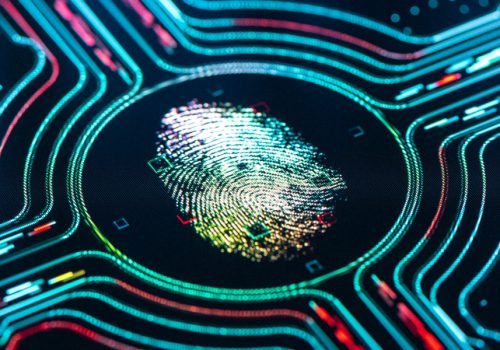The unprecedented digital acceleration triggered by the outbreak of COVID is coinciding with a coming of age for foundational technology and changing the way that we live and work.
Harran blinks in the sunlight, adjusting his eyes. He’s an inquisitive child, enthusiastic for all things new, still he struggles to understand what he’s looking at. A man is pressing marks –triangles or wedges – into a piece of clay, explaining that in this way he can speak to people, even when he isn’t there. While the boy can’t yet grasp how it works, he understands that this will change everything.
I can empathize. More than five thousand years later, the most dedicated linguists still haven’t managed to completely crack the system of writing developed in Harran’s homeland of Sumer. I think of him in this distant, dusty place and wonder what he has in common with today’s children. More than one might imagine. Fast-forward from ancient sand to silicon wafers and we find ourselves in a world where, once again, everything is about to change.
Computing at the Speed of Thought
According to conventional wisdom, and personal experience, our computers get faster, and proportionally cheaper, each time we buy a new model. It’s an observation credited to Gordon Moore, a computer scientist who helped found the chip company Intel, and it explains the exponential growth of computing power that we’ve seen since the first PCs. But while we’ve never stopped getting higher-performance machines with each upgrade, rising costs (from a global shortage of high-grade silica sand to increasingly sophisticated test procedures) have put pressures on manufacturers. It could be a case of more money, Moore problems: as impressive as they are, today’s computers aren’t quite where we hoped they’d be. The prediction was that, at this point, we’d have what is called “exascale” computing, or in other words, a computer capable of carrying out 1×1018 operations per second. (For reference, that’s about a million times faster than current PCs.)
The world’s top supercomputers are now reaching this speed, with eyes on China’s latest supercomputer, Tianhe-3. Whilst factors like dealing with 2020’s global health pandemic may have pushed back the emergence of a bona fide exascale supercomputer, they may also have accelerated participation in community projects like folding@home, which networks personal computers to harness their combined exascale processing power. Though we may never see these speeds on our individual devices, increased processing power is now being combined with new methods of computing that focus on resource efficiency, meaning that the amount of information we can process, and the speed at which we can do it, continues to grow.
The digital transformation of society has just begun.
The Guiding Hand of Standards
In addition to giving scientists a tool to help crack mysteries like COVID-19 and climate change, exascale processing will represent an achievement far beyond simply confirming Moore’s forecast. Scientists believe that at exa-speeds, the computer has about the same neural processing power as the human brain, opening up new horizons in machine learning. The digital transformation of society has just begun.
We could soon be simulating behaviour and pondering problems in a way that we once believed to be uniquely human. The new era of machine learning flips the idea of computer as giant calculator on its head. We’re moving from “tell me how much” to “tell me why, and when”. Instead of being fed numbers and a series of rules with which to crunch them, machine-learning algorithms are fed answers (data) in the hope that they can see the patterns, or rules, that generated them.
Blurring the distinctions between emotion and thought, ideas and information, and substantial and virtual, is just around the corner. What it means in real terms is that many technologies in late infancy, from AI to unbreakable cryptography, could be about to go through a massive growth spurt, locking themselves in their rooms to play loud music and hang out with weird friends.
Let’s not panic. Much as Harran navigated the travails of adolescence and learnt to write cuneiform with the help of expert knowledge and straightforward guidance, ISO standards are there to help us move from potential to practice. We can manage the techsplosion, turning it from firestorm to fireworks.
The Game Changers
The stakes have seldom been higher. We’re living through a period of unprecedented expansion, as tech colonialists scramble for digital supremacy. The dawn of the Internet paved the way for the rise of social media and data capitalism, and in the last decade, giant companies have grown to define and dominate new spaces with unprecedented speed. The challenge for the next generation of would-be unicorns is to gallop into the fields opened by new technologies and to fill them with services, applications and products so significant that, beyond just offering greater consumer choice, they completely tear up the rule book.
Previous game changers, like Facebook and Google, have redefined everyday human experience. Others, like Uber and Amazon, have irreversibly disrupted it. So, while we aren’t going to be making predictions on which horses to back, we have singled out a couple of the leaders that will alter the way that we live and work. Importantly, these are the areas where standards will help us to nurture our tech-driven world from awkward adolescence through to inclusive, sustainable grown-upping. Standing gawkily above the rest of the high-school class is artificial intelligence.
A 2018 report by the European Commission’s Joint Research Centre (JRC) concludes that “the digital transformation of society has just begun: AI is central to this change and offers major opportunities to improve our lives”. With clear echoes of ISO’s own vision of making life better through standards, it’s no surprise that AI, and its associated areas of machine learning, is a hot item for Wael William Diab, Chair of the joint ISO and IEC artificial intelligence team. He is unambiguous that, without standards, nothing can happen: “Standardization is essential to artificial intelligence and its wide adoption across the world.”
Artificial Intelligence
Whilst pop culture may envisage a future of cyborg assistants and intellectual engagement with circuit-board brains, the fact is that AI is already powering a whole raft of decision-making technologies from medical diagnosis to meteorology to self-driving cars. It’s one of the foundational technologies that already underpins the promise of many life-changing applications.
There are many things to consider, with questions of trust, ethics and digital sovereignty drawing comment from futurologists and philosophers as much as tech experts. International Standards are helping to provide answers to both sides of the question. A recent technical report looked into the factors that can impact the trustworthiness of systems providing or using AI, while more than 20 standards currently under development, covering everything from big data reference architecture to governance, to concepts and terminology, are helping to bring this area to life.
Standards are recognized on both sides of the Atlantic, and around the world, as being a core part of AI. As early as 2016, the Obama administration in the US published a series of reports, specifically identifying use of standards as a key priority to keep AI development on course. Meanwhile, the JRC report identifies a further role for standards, stating that “we should think of designing AI applications that are ‘transparent, comprehensible, monitorable and accountable by design’, backed up by frameworks for auditing and evaluating with agreed international standards”.
Standards are recognized as being a core part of AI.
So where will we see the differences? The answer is that, if it’s done right, we’ll have to look very hard indeed to see the AI behind the changes that are coming. There’s a role here for standards too, as a tool for regulators who are under enormous pressure to get it right from the outset. The European Commission report underlines this fact when it says “the first difficulty when deciding about the most appropriate regulatory framework for AI is to anticipate the impact it may have on society. The second is to cope with the pace of AI advances”.
Taking the human factors into account is essential when dealing with a technology that will have a lasting and fundamental impact on people’s lives. It’s not easy to envisage how it will play out, but cities provide a good example of how these elements will interact and operate, fusing cultures, ideas, people, life and work with technology that will change the way that we’ve been doing things for millennia.
The Long and Bumpy Road
Back to the Sumerians, in a roundabout way. Harran was one of the first humans to walk on paved streets. The creation of paving, drainage and infrastructure moved civilization from the idea of loosely formed settlements towards the intentional creation of cities. It was another moment where small developments triggered massive changes. It’s fitting that pavement itself constituted one of the factors that accelerated the world down the road called progress. Despite its twists, turns and checkpoints, we’re still on that road today, bracing ourselves for another dizzying burst of acceleration. Even if 2020 has unhitched some of the horses, the chariots of smart technology are galloping ahead. It may be too early to say, but it seems that the COVID-19 pandemic has triggered re-evaluation and reconfiguration, forcing global cities everywhere to re-examine the way that we live together.
Today, the majority of the world population lives in a city – about 55 %. That proportion has been growing steadily since the 1980s and doesn’t look set to slow any time soon. In fact, the UN reckons that by 2050, seven out of every ten people will be urbanites. Fundamentally, that’s because city living makes sense, especially on a planet where resources are getting scarcer whilst consumption skyrockets. Cities can unite work, living, education and leisure in a single place, reducing the need to move about and enabling more efficient, collective use of resources, from heat and light to Wi-Fi.
Urban planners understand that to keep cities fit for purpose, a joined-up approach is needed. But how to consider and account for the differing needs of 10, 20 or 30 million people living side by side? Data-driven analysis of what residents need, and when they need it, combined with the power of connectivity, is one of the key concepts behind the emergence of the first smart cities. The idea isn’t new, with the International Standard defining smart city concepts published back in 2017, but now we’re at a point where those concepts are fast becoming necessary realities.
Putting People First
Smart cities don’t represent a foundational technology in themselves. Instead, they combine recent and emerging technologies; in particular, always-on connectivity, AI and the Internet of Things. In a societal sense, smart cities are true game changers, though. By combining options for green transport, from contactless-pay electric mobility to ridesharing and even old-fashioned walking, properly configured smart cities will be quieter, cleaner and healthier. By understanding what people actually do (as opposed to what planners think they should do) and enabling access on demand, capacity can be managed when it comes to public services, delivering efficiency and value for money. In a smart city, queuing in a government office to renew a permit, or query a bill, should be a thing of the past. It’s about providing people with alternatives that work for them, at the same time as offering incentives to change behaviours that simply won’t be sustainable in future.
ISO standards on smart cities bring clarity and offer options. For example, standards that cover the basics of terminology ensure that everyone is having the same conversation, even if there’s no single formula for a smart city. Most locations won’t have the luxury of starting from scratch, and many of the longest-established metropoles face similar challenges around infrastructure that was designed for a different era. As we look at ways to improve, ISO standards can be applied to answering many of the questions about how we want to live and work, questions that have become ever more pressing in the light of the COVID-19 pandemic.
A Roadmap for Shared Success
Whilst new technology is always greeted with moderating voices that range from wishful thinking to outright panic, few of the predictions made come to pass. That means that fewer still can be reliably acted upon.
Perhaps the best that we can hope for is an open conversation and a shared trust in the value of humanity. This relies on goodwill and a generous pinch of optimism, but there are more concrete reasons why I’m hopeful for the current generation of Harrans. They will be guided by a multilateral outlook, following established rules and clear procedures set at a global level.
Standards help achieve this, at the same time as creating a basis for ongoing innovation and the widest participation possible. ISO’s catalogue of more than 20 000 standards means that, far from starting at square one each time, both new and established interests can coexist on a level playing field. It’s a proven system built on international work and consensus, and it provides a place where innovators can nurture their ideas. Secure in the knowledge that the fundamentals are covered by International Standards, 100 % of efforts can be directed to developing distinctive products, a competitive edge and technology that works for everybody.
There’s a lot riding on making the right choices, and for ISO, that only strengthens belief in our mission. Standards will continue to grow in importance, as population, activities and devices continue to multiply. As the world reboots its navigation system, we need a reassuring voice that helps keep the journey on track. At a time when we’re collectively putting the pedal to the floor, it’s just one less thing to worry about. So sit back and enjoy the ride as the scenery starts to blur. Harran’s bumpy road has just become an expressway.
Disclaimer: PECB has obtained permission to publish the articles written by ISO.









